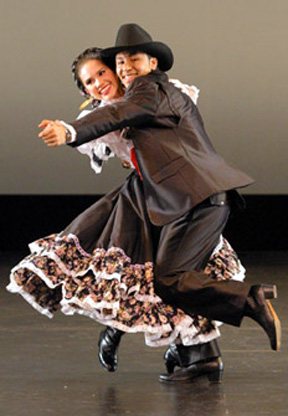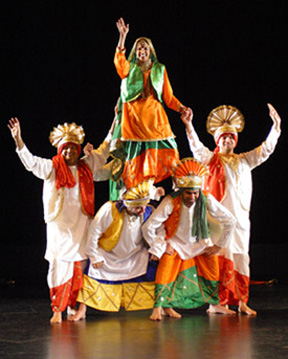You Can't Miss the Joy
2004
San Francisco Ethnic Dance Festival
World Arts West
Palace of Fine Arts
June 13, 2004
By
Rita Felciano
Copyright
© 2004 by Rita Felciano
published June 14, 2004

Out of the initial 100 companies which auditioned last January, 24 will perform during this year’s three weekend run; 14 of them for the first time.
Joy is probably as a good an explanation as any why audiences return to EDF year after year. For the companies it’s the one opportunity to present themselves outside specialized, and much smaller audiences. So when these dancers, clad in glitter, raffia and silk, cram themselves onto the Palace of Fine Arts stage for a final bow, you can’t miss the joy.
But on another level, even though most of these are theatricalized versions of specific dances, the EDF also serves as a reminder of dance as a social activity, of something that people do together. Performers, who may have never seen a manioc or bamboo field, enact rituals of planting, cultivating and harvesting. The crop their labor yields is intangible, but just as nourishing as a basket of fish or a bushel of wheat. As audience members, if we can’t do it ourselves, at least we can watch it. After all, even when these dances—whatever their original form—were seen on village squares and in community halls, they were always surrounded by watchers, listeners and commentators.
Nostalgia, the identification with older, simpler, and therefore better ways of life no doubt plays a role at the EDF. For many of its audience members and dance participants, being part of such a performance practice provides a connection to what they have left behind. While the specificity of the dances may provide some rooting and intellectual understanding of a culture different from this one, my suspicion is, however, that the primary benefit lies in this being a communal activity.
The quality of the first weekend’s performances, while generally good, varied to a considerable degree. Chitresh Das Youth Company, for instance, featured an octet of teenage Kathak dancers. While performing with charm and skill, these young women were inexperienced on the stage and not at ease. (At other performances, they would have been seen in tandem with the professional company). To showcase them in isolation was not a good idea.
Hala Dance’s seven women presented two Middle Eastern pieces, a cane dance from Southern Egypt in which the performers recalled herding, shaking fruit from trees, simple walking and circle patterns. It was followed by an intrepretation of a popular love song. The costumes, black silk interwoven with elaborate gold and silver patterns, were luscious. The cane dance also featured a hiplong matching head scarf. The performance, however, looked anemic, with the movements suffering from insufficient articulation. They simply didn’t project from this large stage. It also didn’t help that they were presented to overamplified taped music. (In recent years, EDF has made a concerted effort, to push for live music).
RAICES Grupo Folklorico, claims that the polkas were born in “the 16th century parlors of Europe.” I doubt it. However, bringing them to Mexico by immigrants from Germany and Czechoslovakia—one of the side effects of Mexico’s domination by the Austro/Spanish empire—is more plausible. Polka was born as a peasant dance, probably in Bohemia. Even reshaped and adapted to its Mexican soil, there remains a roughness about it—especially visible in shoving back and forth arm motions. The fast stomping, high kicking footwork, the twirls for the women that, probably, were originally scandalous since they revealed the women’s bloomers, and the teasing flirtations make this a fun dance to perform. It demands speed and stamina, of which RAICES had plenty, but ultimately the unremitting cheer wore thin. The attempt at bravura was also somewhat heavy-handed. Again, here as well, the demands of live music would have challenged the dancers to be more than fast and together.
With Likha Pilipino Folk Ensemble, Dunsmuir Scottish Dancers, Ghungroo Dance Company and Halau Aloha Pumehana ‘o Polynesia, the EDF went into high gear, showing dances of intrinisic interest, well performed. Halau, which performed a suite of works honoring and telling about the goddess Pele, is a large ensemble. The counterpoint, set up by the low to the ground, leisurely hip swings, the flat footed or slightly elevated steps and the strong arm patterns, resonated strongly in part because of this being a group so clearly in tune with itself. The dancers moved like a force of nature. At times they performed in unison, at the times the men separately from the women. The presentation was also enlivened by the call and response chanting between the singer and the ensemble. One was finally left with a strong sense of this being one people, moving and, I guess, praying together.
Halau was followed by Likha, a group that presented an interpretation of a Bagobo harvest dance from the Southeastern Philippines. Elegant and formal, with precisely calibrated spatial patterns that controlled the whole dance, the piece featured a hiccupping skipping step that would have would look casual in a less controlled environment. While the work gestures—preparing the soil, throwing seeds, cutting crops—were still legible, their stylization and control elevated them above the mundane. The men performed with long bamboo poles, at one point creating a quasi abstract pattern in a line dance that connected them with each other by means of the poles laid on their shoulders. Live, well performed music and gorgeous costumes, particularly the men’s tapestry-like suits and headdresses with ear rings, should also be noted.
Dunsmuir is a twenty-three year old Scottish Country Dance group which still may include some founding members since all of the facial hair was gray. The wonderfully erect postures, the lightness of the footwork, the gentile courtesy with which these men and women interacted prompted my seat mate to comment on what a wonderful gift Mary Queen of Scots had taken back to her native land. These were experienced, well trained dancers performing what they love to do. It was particularly wonderful to see four middle aged men dancing a hand-holding reel. The live music, with thankfully, just a little bit of bagpipe, featured among others a step dancer whose metallic beat wove its percussive rhythm throughout the dances.

The evening was marred by but one glaring misstep; a booming, rather pompous voice over introduction of each company. Why? The program notes were more than adequate. And why not trust the dancers to do what they do so well?
Originally
published:
www.danceviewtimes.com
Volume 2, Number 22
June 14, 2004
Copyright ©2004 by Rita Felciano
|
|